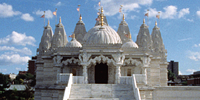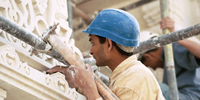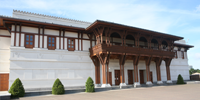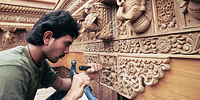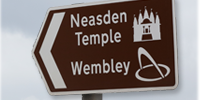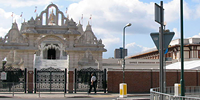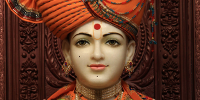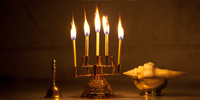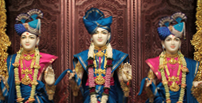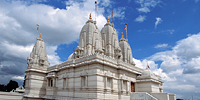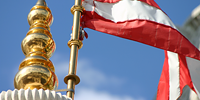History of BAPS in the UK & Europe
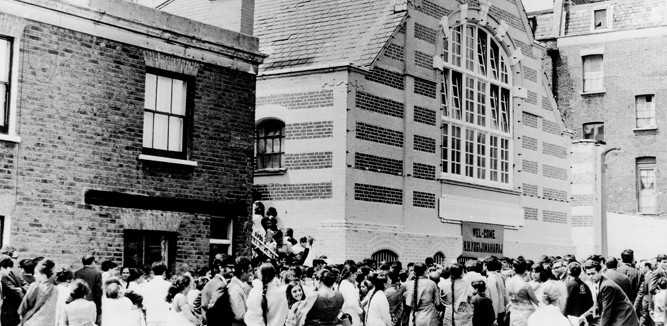
The seeds of BAPS in the UK were sown in the middle of the last century, when, in 1950, with the blessings of Shastriji Maharaj, Mahendrabhai Patel (‘Barrister’), Purushottambhai Patel, and a few other devotees began to meet occasionally for Satsang in London.
Mahendrabhai: I landed in London in 1950 for further studies. Purushottambhai was a devotee of Shastriji Maharaj living in Kent, whose address was given to me by Yogiji Maharaj.
Yogiji Maharaj often wrote to the devotees to meet regularly for Satsang. Gradually, Indians, still few in number, began arriving in London.
In 1953, in India, Yogiji Maharaj blessed Dahyabhai D. Meghani (nephew of the renowned Gujarati scholar and author, Zaverchand Meghani), saying: “Go to London, and ensure you continue to practise Satsang.” On arriving in London, Meghani, Chandubhai, Maganbhai and others started to meet on a regular basis.
Pramukh Swami Maharaj: In London, D. D. Meghani, his brothers and friends had been holding Satsang sabhas in his office since 1953. They would read Yogi Bapa’s weekly letters. Later, arrivals from India and East Africa – Navinbhai Swaminarayan, Prafulbhai Patel, Chitranjanbhai and others – joined in and started the weekly assembly at the house of Prahladbhai, the son-in-law of Ravjibhai of Jinja (Uganda), in 1958.
The Saturday evening assemblies at Prahladbhai’s house in Seymour Place near Baker Street station attracted a few devotees. After the ritual dhun and kirtan singing, the assembly concluded with a spiritual discourse by a devotee. The annual Annakut festival was also celebrated at his house for several years.
Times were hard in 1950s London. Initially, even preparing Indian food was difficult. Green vegetables, pulses and grains were hard to come by. Many devotees speak of living on bread and tea for months.
In the summer of 1959, a constitution for the Satsang Mandal was drafted, and registered under the name of ‘Swaminarayan Hindu Mission, London Fellowship Centre’. D. D. Meghani was appointed as Chairman of the Mission, Mahendrabhai Barrister as Vice Chairman, Prafulbhai Patel as Secretary, Chandrakantbhai N. Dhupelia as Treasurer, and Navinbhai Swaminarayan enlightened the Satsang assemblies with his spiritual talks and experiences.
In September 1959, Gulzarilal Nanda (the then Union Labour Minister of India, and later acting Prime Minister of India) visited London during his trip to Europe. Yogiji Maharaj wrote to the devotees to organise a reception in his honour. The Indian High Commissioner in London, Mrs Vijayalaxmi Pandit, was contacted and briefed about the reception. Held at Vega Restaurant in Central London, over a hundred dignitaries and guests were present at this first public Satsang function. D. D. Meghani welcomed Nandaji in his speech, and introduced Yogiji Maharaj and the activities of the Satsang Mandal. Nandaji was impressed by the youths and devotees who, though living in a far off land, were wedded to the moral code prescribed by Bhagwan Swaminarayan and Yogiji Maharaj.
The centre was nourished by regular letters from Yogiji Maharaj and visits by learned devotees. Ravibhai Pandya of Mombasa (Kenya) often made business trips to London and also inspired the devotees with his talks. In 1962, Harmanbhai Patel from Nairobi (Kenya) visited London solely for the purpose of consolidating Satsang and encouraging the devotees.
In 1964, Navinbhai Swaminarayan started a Satsang assembly in Manchester.
In 1970, during Yogiji Maharaj’s visit to East Africa, devotees in London invited him to grace London. Yogiji Maharaj said that he would come if they acquired a place for a mandir. A historic conversation transpired over the telephone between the devotees of London and Yogiji Maharaj in Tororo (Uganda). With the blessings of Yogiji Maharaj, the devotees started exploring London for a suitable place.
A few years earlier in India, while looking at a map of London, Yogiji Maharaj had marked with a pencil the location of a place which would be suitable for a mandir. In May 1970, a property was indeed found on that very marked spot.
Pramukh Swami Maharaj: The number of devotees was small for establishing a mandir. But their desire to call Swamishri [Yogiji Maharaj] to London and his wish inspired their efforts. On searching, they came upon an old church [St John’s Baptist Church in Islington, East London]. The proprietors asked for £12,000 and the devotees made an offer of £9,500. A devotee, Jayantibhai of Changa, had a vision of Yogi Bapa in a dream, who told him that they would get the church for around £9,000. And that was exactly what happened. The next day the church authorities said, ‘You are doing good work and so we will sell it to you for £9,500.’ By the wish of Swamiji, the church [on 77 Elmore Street] was bought to create a mandir.
Yogiji Maharaj arrived in London on 23 May 1970. On his arrival, Yogiji Maharaj said in his blessings:
In an assembly at a Methodist church in Park Lane, Wembley, Yogiji Maharaj revealed:
The church in Islington, London was refurbished and the first Swaminarayan mandir in the western world was inaugurated by Yogiji Maharaj on Sunday 14 June 1970.
Pramukh Swami Maharaj: After restoring and re-decorating the church, sacred images which had been sanctified by Shastriji Maharaj and given to Prabhudas Lalaji were brought from Kampala (Uganda). A yagna [Vedic ceremony] was performed and thousands witnessed the procession, after which the murtis were joyously installed in the new mandir.
Pramukh Swami Maharaj: During his stay, Swamiji [Yogiji Maharaj] stayed at Arvindbhai Patel’s home in Dollis Hill for one-and-a-half months, while the sadhus stayed at Chitranjanbhai’s place. Every morning, the puja [ritual prayers] was held at the house in Dollis Hill, and every evening, assemblies were delivered in the new mandir. The devotees prayed to Swamiji, ‘Though the mandir is ready, there are only a few devotees. Do bless us that Satsang grows.’ Swamiji enthusiastically showered his blessings, saying, ‘One day, this mandir will be too small to accommodate the devotees. Satsang will flourish throughout London. A great shikharbaddha mandir will be erected. Hundreds of thousands of people will benefit.’
Yogiji Maharaj and the sadhus stayed in the UK for 6 weeks. In addition to London, they visited Leicester, Loughborough, Luton and a few other places close to London. They returned to India on 7 July 1970.
Yogiji Maharaj passed away on 23 January 1971 at the age of 78. The reins of the fellowship were assumed by His Holiness Pramukh Swami Maharaj.
On 14 June 1972, in the village of Piplana (Gujarat, India), Pramukh Swami Maharaj recalled the vision of his guru and prayed: “May there be a marble shikharbaddha mandir in London and may a hundred sadhus grace the opening ceremony.”
In 1972, thousands of devotees and Indians expelled from Uganda emigrated to England. The Islington mandir could not accommodate the ever-increasing tide of devotees. G. D. Patel, a veteran devotee, played an important role in enlightening the growing congregation with his spiritual talks. During festival days, hundreds of devotees had to stand outside on the streets.
In 1974 in the mandir in Islington, Pramukh Swami Maharaj ceremoniously installed the large painted murtis of Akshar Purushottam Maharaj, Shri Radha-Krishna and the Guru Parampara which had been retrieved from the Tororo mandir just prior to the Ugandan expulsion of 1972.
In 1977, Pramukh Swami Maharaj visited the UK and opened small mandirs in Ashton, Leicester and Wellingborough.
Pramukh Swami Maharaj: Later through his [Yogiji Maharaj’s] blessings, and the divine grace of Bhagwan Swaminarayan and Gunatitanand Swami as well as the vision of Shastriji Maharaj, a new site of 2.25 acres was acquired [on Meadow Garth] in Neasden. The factory site was renovated to create a mandir and an assembly hall.
The ground-breaking ceremony was performed on 20 July 1980 by Pramukh Swami Maharaj. In 1982, Pramukh Swami Maharaj performed the opening ceremony of the new mandir in Neasden. It was around this time that Swamishri first proposed the idea of building a traditional, shikharbaddha mandir in London. The original plan was to construct the mandir on the Meadow Garth site itself. After due consideration with architects and engineers, it was evident that the existing premises would be far too small and unsuitable for the purpose.
In the meantime, the small scattered patches of Satsang around the UK continued to grow and new centres flowered in Preston, Birmingham, Coventry, Luton, Crawley, and other places. C. M. Patel, Chairman of UK Satsang Mandal, warmly encouraged the growth and development with his tireless efforts.
In 1984, a much larger plot of 4.5 acres of land was acquired in Harrow, north-west London, for a new mandir. But planning permission was eventually refused by the Department of Environment in December 1986.
In 1985, the Cultural Festival of India was celebrated on the grounds of Alexandra Palace in London. During the annual Annakut festival in London, thousands of devotees and well-wishers would come for darshan at the Neasden mandir.
In 1990, it came to light that the Arlington garage and warehouse opposite the existing mandir on Meadow Garth had been put up for sale. Swamishri asked devotees to enquire, and the site was eventually purchased later that summer on the instructions of Swamishri.
On 7 July 1991, Swamishri laid the foundation stone for a shikharbaddha mandir.
Work on the new mandir began in November 1992, and in just two-and-a-half years, a traditional stone shikharbaddha mandir was completed with the efforts of hundreds of volunteers.
BAPS Shri Swaminarayan Mandir, London was inaugurated by Pramukh Swami Maharaj on 20 August 1995 as part of the six-day Mandir Mahotsav celebrations.
To view a timeline of the history of BAPS in the UK and Europe, please click here.
